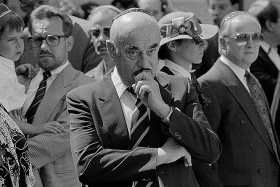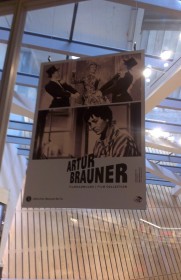Film Historian Claudia Dillmann on the Artur Brauner Film Collection in Our Library
The German film producer and Shoah survivor Artur Brauner has kindly donated to our Museum twenty-one films on the subject of the Shoah and the Nazi era—you’ll find the complete list on our website. Today, the Museum acknowledges our great appreciation of this gift with a special event in the presence of Artur Brauner and his family.
Prior to the event we interviewed film historian Claudia Dillmann about Artur Brauner and the appeal of his film productions, in particular for a Jewish Museum. Ms. Dillmann is Director of the German Film Institute in Frankfurt Main and a renowned expert on Artur Brauner, and also initiated the online resource www.filmportal.de. She talked to us about Brauner’s interest in the victims of Nazi crimes, the balancing acts it has called for, his veneration of Romy Schneider, and the German public’s tastes.
Mirjam Bitter, Blog Editor: Ms. Dillman, in your opinion, how representative is our Artur Brauner Film Collection of Mr. Brauner’s entire production list?
Claudia Dillmann: The films that Artur Brauner has donated to the Jewish Museum are indeed representative since they constitute a pivot of his career—one very dear to his heart—namely an abiding commitment to exposing the Holocaust, not least because forty-nine of his own relatives also lost their lives then. He sees these films as his personal “legacy,” one he has been forging since the start of his career. They are dedicated to victims of the Nazi regime and constitute a cycle that in his view is still not complete. In them, he has continually explored new facets of persecution under the Nazi terror and of the traumata he lived through himself.
Given their subject matter these films were not exactly box-office hits in Germany and, in fact, often a financial disaster for Brauner. He managed to fund them largely thanks to his success, over several decades, in producing lighter entertainment: films in which he was more willing to bow to popular tastes. These, the other pivot of his career, are no less relevant to the postwar history of West German cinema.
This financial balancing act attests the great professionalism of his film production company. Launched in the early 1950s, it had dramatists, screenwriters, set builders, lighting technicians, cameramen and directors on the payroll for a good three decades, to say nothing of renowned actresses and actors with experience both of the silver screen and the theater. Since the 1980s Artur Brauner has tended less and less to regard profit margins as the measure of his success. Taken as a whole, the films he produced comprise a visual history of the mind-set of the Federal Republic.
What makes Artur Brauner’s productions so fascinating, in particular for a Jewish Museum?

Artur Brauner at Heinz Galinski’s funeral, 24 July 1992
Jewish Museum Berlin, photo: Michael Kerstgens
Of course, the numerous Holocaust films that Artur Brauner has produced throughout his career are fascinating in many respects. For one, the screenplays initially derived from his first-hand experience as a young Holocaust survivor—as someone directly and deeply touched by this history. As a rule, his films explore neither the causes of Nazi dictatorship, nor the motives of Nazi criminals, but rather their victims. And very often, in Brauner’s films, the victims are children and young people.
Already in his second venture, Morituri, produced on a shoestring amid postwar upheaval in 1947/48, he portrays a group of concentration camp fugitives, hiding out in a forest. The ensemble film seeks to convey something of the anonymity and sheer iniquitous number of victims of Nazi terror, of all victims, of all nations, irrespective of why they were persecuted. In one key scene, for instance, Morituri rejects the idea of collective guilt and denies its characters collective retribution.
Yet the film’s reception was a clear indication at the very start of Artur Brauner’s career of the hostility he was to face throughout his entire Holocaust film cycle: disinterest or even outright rejection of his work by West German cinema-goers, plus a lack of appreciation and acknowledgement among West German critics. Take as just one example the film Europa Europa [Dir: Agnieszka Holland, 1989/90, original title: Hitlerjunge Salomon]. It was overwhelmingly acclaimed internationally, very particularly so by audiences in the USA, and also won a prestigious Golden Globe—yet the German selection committee failed to nominate it as Germany’s favorite for an Oscar. I presume that the film’s hilarious yet painfully true story simply didn’t sit easily with the German public’s politically correct notion of how the Holocaust should be addressed. Which is hard to swallow. To this day Artur Brauner feels that he was robbed of the chance to crown his life’s work with an Oscar. And I think he is right.

Some Artur Brauner films are no longer available for purchase – but you can watch them in our reading room, in a comfortable film lounge created with Brauner’s generous support specifically for this purpose.
CC-BY Jewish Museum Berlin, photo: Mirjam Bitter
It’s fantastic that all these films are now available to the general public in the Jewish Museum Berlin, and integrated in the Museum’s educational programs. For some are not available on DVD and relatively few people get to see them. In particular for the younger generation, the films are an ideal means to foster critical insight, and discussion of Nazi crimes and their impact.
Today we’re screening Europa Europa for Berlin schoolchildren, after which there’ll be a Q&A with Artur Brauner as a contemporary witness to that era. This evening, at our regular Monday Film Night, there’ll be a public screening of The Passerby [original title: La passante du Sans-Souci], the French film classic from 1982, with Romy Schneider in her final role. Could you tell us something about this film too? What do you think makes it special?
Well, of course Romy Schneider herself, in a sense, here in what was not only her last but also a demanding double role. Her outstanding performance alongside Michel Piccoli was widely acclaimed at the time, whereas the film itself struck many critics as artificial. Romy Schneider’s pivotal importance for the project is evident in part from the opening credits, which state that the film is dedicated to her deceased husband and son—the latter had suffered a fatal accident only a few months before the premiere. Moreover, this leading lady and major star made no secret of her acute consciousness of German war crimes and her critical position on her homeland’s recent past, including her own family’s part in it. Artur Brauner was a fervent admirer of Romy Schneider, and therefore especially eager to co-produce this German-French venture.
But what is really interesting is that the film was released back then with two different endings. Visually, the two versions remained more or less the same, but the German one didn’t include the text inserted in the French version to explain the characters’ subsequent fate, namely the fact that they were shot shortly afterwards by neo-Nazis. It is astonishing to note that Artur Brauner, who otherwise never shied conflict, was in this case prepared to accept such a change in consideration of the German public’s taste—or so it was said. And that says a great deal.

Our reading room is in the W. Michael Blumenthal Academy designed by Daniel Libeskind, which is situated opposite the Museum entrance.
CC-BY Jewish Museum Berlin, photo: Mirjam Bitter
As early as 1989, you had Artur Brauner’s archive transferred to the German Film Museum for scholarly analysis, and then curated an exhibition there about his work. Could you please say something more about Brauner himself? What are his most striking qualities as a man and as a producer?
Well, with his 98th birthday coming up and his seven-decade track record in film, Artur Brauner is certainly an exceptional man, and one who—if ever he slowed down long enough—could look back on over three hundred productions for cinema, which is probably a record-breaking number. He is obsessed by film, and also indefatigable in his striving to realize his ideal of top-quality entertainment and edutainment. He is a real live wire and always has been, professionally and in private: restless, agile, and ready to leap into action any second. He is also a sound businessman who drives a hard bargain. Were he not, his life’s work would never have seen the light of day. These are the qualities that enabled him to fight his way to the top of the film branch and the higher echelons of West German society in the 1950s, whatever the opposition, whatever the odds. Which was no mean feat, back then, for a Polish Jew who had arrived in war-torn Berlin with nothing but a suitcase to his name.
In the twenty-seven years of our acquaintance I personally have found him to be always fair, generous, witty, charming, and smart: and also one hundred percent earnest about his work, in particular about his Holocaust films. He still plays an active role in pushing projects through, although his daughter Alice, who is now an outstanding film producer in her own right, joined him as co-director of the company some years ago. And he alone, in the postwar period, created a series of films “made in Germany” that expressly sought to honor the memory of those persecuted by the Nazi regime.
Sincere thanks for your insights!
You’ll find details of our free Monday Film Night—tonight at 18:30—in our events calendar.
And you can learn more about Artur Brauner’s life’s work in the following publications by Claudia Dillmann:
- Dillmann-Kühn, Claudia, Artur Brauner und die CCC. Filmgeschäft, Produktionsalltag, Studiogeschichte 1946–1990. With a filmography by Rüdiger Koschnitzki and an epilog by Bernd Eichhorn, Frankfurt Main 1990.
- Dillmann, Claudia, “Zu bittere Kräuter. Zeugin aus der Hölle. Die Produktion und Rezeption eines ‘riskanten’ Films,” in: Claudia Dillmann, Ronny Loewy (eds.): Die Vergangenheit in der Gegenwart. Konfrontationen mit den Folgen des Holocaust im deutschen Nachkriegsfilm, Frankfurt Main 2001.
- Dillmann, Claudia, “Der Filmproduzent Artur Brauner,” in: Artur Brauner. Produzent, Producer. Published by Goethe Institute Inter Nationes, Munich 2002.
- Dillmann, Claudia (ed.), 2 x 20. Juli. Die Doppelverfilmung von 1955, Frankfurt Main 2004.
- Dillmann, Claudia, “Der Tycoon,” in: Ihn gibt’s nur einmal. Artur Brauner zum 90. Geburtstag, Frankfurt Main 2008, p. 8–13.
